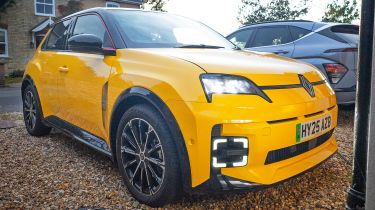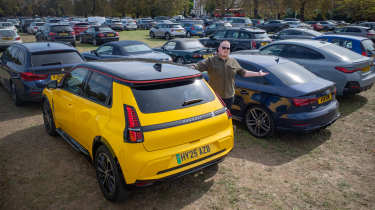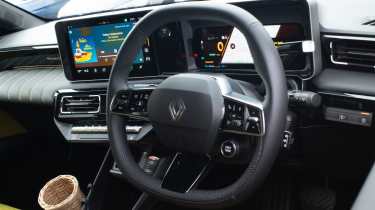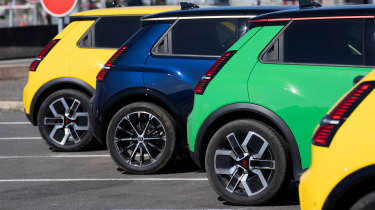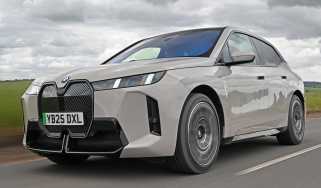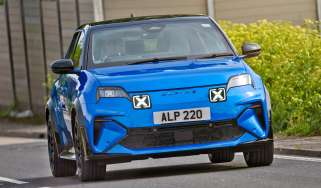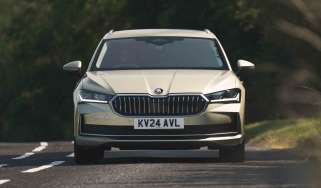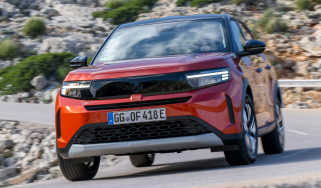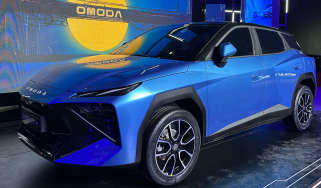Long-term test: Renault 5 E-Tech Iconic Five
Third fleetwatch: we all drive the yellow submarine as the Renault 5 keys pass to a new captain

By the time you read this, ‘my’ Renault 5 will be in the arms of another man. Those of my colleague Tom Jervis to be specific, because Auto Express’s consumer reporter will get to enjoy life in the yellow submarine for a few months. Taking the French EV’s place on my driveway will be the fiery Abarth 600e Scorpionissima.
Hopefully Tom will concur with my findings, which is that the Renault 5 is an absolutely brilliant car to spend any amount of time in. Indeed, as we part ways, I think I may not have appreciated just how comfortable and forgiving the ride in Renault 5 is.
The same goes for just how easy it is to use the technology onboard, and I maintain that Renault’s Google-powered infotainment system is one of the very best around at the moment.
Similarly, I’ve found the real-world range of the R5 to be about 220 miles – not far off the 250 miles Renault says it will do. The warm summer weather will have helped me eke out a few extra miles from the car’s 52kWh battery.
But then again, I’ve spent a lot of time driving this electric supermini back and forth to Heathrow and Gatwick airports on the M25 motorway, and enjoyed the occasional blast along my local B-roads. So I’ve not exactly been hypermiling it during my time with the Renault 5.
Renault 5 E-Tech Iconic Five: third report
Our retro Renault’s star is still shining wonderfully bright
- Mileage: 4,782 miles
- Efficiency: 4.0 miles/kWh
Did you know that grey has been the most popular paint colour for new cars in the UK for the past seven years in a row? And it’s not like we’ve just had the joy sucked out of us since Toys ‘R’ Us went bust. Silver had a six-year run as the go-to hue from 2003, then it was black, then white, then black again.
This doesn’t surprise me one bit, though, because every time I’m stuck in traffic on the M25 (which is all too frequently), it feels like I’m surrounded by more shades of grey than even E.L. James could shake a stick at.
Likewise, when I went down to London’s Hampton Court Palace to attend the Concours of Elegance – an event featuring genuinely immaculate cars from every era of motoring, and in some of the wildest colours imaginable – the visitors’ car park outside looked as monochromatic as TV in the fifties. But as always, standing out amongst the crowd was our Renault 5 with its brilliant (and suitably named) Pop Yellow! paint.
I’m sure my affection for the Renault 5 has come through in these reports, but I haven’t been the only one smitten by its charms. Perhaps unsurprisingly, the car’s vibrant colour combined with its nostalgic looks has turned many a head since I picked up the Renault back in April. Even now, several months later and with plenty of R5s on the road, most journeys include at least one nod of approval from a fellow motorist.
Dozens of people have come up to me to ask about the car since it became ‘mine’. That’s everyone, from those who were on the cusp of buying one themselves, to a pair of burly builders who fondly remembered the original from their childhoods and revelled in all the little references sprinkled throughout this latest model. If I was forced to pick one, my favourite detail is the colourful pictorial history of the Renault 5 tucked away in pockets on the backs of the front seats.
Like me, most people don’t realise how much metal flake is actually in the Renault 5’s vibrant yellow paint until they see it for themselves. And while not everyone loves the shimmering bumblebee look, those I spoke to who have either already placed an order for a Renault 5, or were going to after taking a look around ours, weren’t opting for a run-of-the-mill black or white one.
Instead, the standard (but no less eye-catching) Pop Green! or more understated Midnight Blue seem to be the next most popular choices. Which goes to show, if car manufacturers are willing to offer these kinds of bright, bold hues, customers aren’t afraid to go for them.
Especially on a small, fun and characterful car such as the Renault 5, which has been a perfect companion for me. It’s easy to drive around town, fun to fling around on a twisty B-road and quiet on the motorway, plus the ride strikes an ideal balance between comfort and composure. On top of all that, my average efficiency has been an impressive 4.0 miles per kWh, and across a mixture of roads I can get around 230 miles from a full charge.
Meanwhile, the 326-litre boot capacity has been more than enough for daily needs and weekend trips away. Rear legroom isn’t all that generous, but this is a supermini and I don’t have to pull the front seats forward too much for another adult to squeeze into the back. Of course, if space is a priority for you, since the Renault 5 joined our fleet, the boxier and longer Renault 4 has arrived, creating a talented double act in the brand’s showrooms.
I have just three gripes with the Renault 5. First, it doesn’t have the one-pedal driving capability of the R4, but that should be added at some point. Next, I’ve found you have to be very firm with the gear selector going from drive to reverse. And because of where it is on the steering column, I still occasionally turn the wipers on when doing quick manoeuvres.
Finally, there’s the AI-powered ‘Reno’ voice assistant. I wasn’t convinced it would be all that helpful anyway, but it became genuinely annoying when the Microsoft paperclip wannabe started to randomly pipe up, even when I didn’t summon him. Needless to say, I quickly turned him off, partly because I kept feeling guilty seeing Reno’s sad expression when I told him to go away.
But frankly, I’ve loved the Renault 5 since I picked it up from the factory in France. So much that a wheel would probably have needed to fall off to spoil my opinion of it.
Renault 5 E-Tech Iconic Five: second fleetwatch
Renault’s AI ‘Reno’ can help on the move, but its unprompted interruptions are testing my patience
I'm not sure if putting AI in cars is a good idea or a gimmick, but I’m hoping my new friend ‘Reno’ will help make my mind up. Renault’s equivalent of the Microsoft paper clip is powered by ChatGPT, and can lower the windows and give driving tips. I’ve warned him against any back-seat nagging, but he’s started popping up unprompted already. Sterner words may be required to get him in line.
Renault 5 E-Tech Iconic Five: second report
We compare our beloved R5 with Alpine’s closely related A290
- Mileage: 3,512 miles
- Efficiency: 3.9 miles/kWh
In case you hadn’t heard the news, the Renault 5 took home the now fiercely contested title of Auto Express Affordable Electric Car of the Year in our New Car Awards. And it’s not simply because prices for this obscenely charming EV start from under £23,000; another big reason is that it’s great to drive, no matter what situation you throw it into. I assumed that, being such a chic small electric car, the French fancy would have a crisis when driven outside town or above about 30mph. Yet it’s quiet and feels stable cruising on the motorway, while on a twisty country road it’s very composed and up for being chucked into corners.
Other than the fact that I’ve been averaging a very respectable 3.9 miles per kWh, the Renault 5’s impressive road manners have been the biggest surprise after living with the car these past few months. Which made me think: if the regular model is so well rounded and great to drive, then why might someone pay extra for its evil-looking twin, the Alpine A290? To find out which of the pair I’d rather have if I were walking into a dealership today, I decided to get them both together for some back-to-back testing.
Now, I love the retro design of the Renault and its glorious pop yellow! paint, however Sonic the Hedgehog (as I’ve christened the A290) really appeals to the boy racer in me and looks – for want of a better term – like a serious bit of kit. The Alpine is 60mm wider than its sibling, which doesn’t sound like a lot, but you immediately notice the difference when the two are parked side-by-side, thanks to the A290’s flared wheelarches. There’s also the more aggressive bumpers, extra rally-inspired lights, and the go-faster grooves in the rear doors – which remind me, rather oddly, of a 1968 Dodge Charger.
The interior feels like a more grown-up place as well, because the example I was testing was the top-of-the-range A290 GTS, which starts from £37,500 and swaps the R5's recycled yellow fabric upholstery for more sophisticated blue and white Nappa leather.
It also features a taller centre console to make the cabin feel more like a cockpit for the driver, plus the A290’s steering wheel has a devious red ‘overtake’ button and a separate ‘recharge’ dial for switching between four modes for the regenerative braking – rather than simply D or B modes in the Renault.
My favourite upgrade, though, is the new drive selector. This is lifted straight from the incredible Alpine A110 sports car, and I found it much easier to get along with in everyday use than the column-mounted item in the Renault, especially when trying to pull off quick manoeuvres. More than once in the R5,I’ve flicked the shifter down to go into Drive and come close to having a scrape with something because the car’s stayed in reverse.
In all honesty, though, this is one of my few gripes with the car. However, the lack of cup-holders in the A290 is rather annoying, as is having the charging cables taking up space in the boot because of a sub-woofer sitting where the underfloor storage is in our R5.
As you’d expect, there are some differences in the two cars’ driving experience as well. For instance, in the Alpine there’s a synthesised, Star Trek-esque sound when you accelerate, which I’m a fan of, and the Renault’s already responsive steering has been made even more precise. The A290 feels more sure-footed than its sibling too, giving you more confidence
to go around corners at even higher speeds. And yet, the Alpine manages to absorb bumps better, thanks to its hydraulic bump stops. The GTS version also has around 70bhp extra on tap, so it feels punchier off the line and there is even a little torque steer when you floor the throttle.
But despite all that, the A290 doesn’t feel any more engaging or fun to drive. Instead, it just delivers more of everything you get in the Renault 5 – something that I see as a compliment to the latter, which doesn’t take itself as seriously either. Ultimately, both the Renault and its closely related Alpine sibling are fantastic small EVsthat offer different interpretations of fun, and choosing between the two simply depends on which suits your personality more. For me, that’s the Renault.
Renault 5 E-Tech Iconic Five: first fleetwatch
Renault embraces its heritage with the most French accessory ever
The tricolore hidden in the headlights and the various cockerel easter eggs are relatively subtle nods to the Renault 5’s French heritage. The wicker baguette holder, on the other hand, is so stereotypically French it has to have been thought up by a Brit. Regardless, it’s easily one of the most ridiculous accessories a car maker has ever offered, and it’s safe to assume that every new R5 owner is going to be receiving one for Christmas.
Renault 5 E-Tech Iconic Five: first report
Does the retro-inspired electric supermini live up to the massive hype?
- Mileage: 1,586 miles
- Efficiency: 3.6 miles/kWh
The Renault 5 E-Tech is one of the most sought after, hotly anticipated new cars in recent memory. I was completely smitten by the concept model when it was presented in 2021, and have been hanging on every word about this car ever since. So as you can imagine, I’m extremely excited to be living with one for the next few months, and hope to be grinning the entire time.
But I was worried that Murphy’s law (anything that could go wrong, would go wrong) might interfere somehow. To ensure no one stole our R5 in transit, or its arrival from France wasn’t delayed, I decided to pick up the car myself from Renault’s incredibly impressive ElectriCity plant, just outside the town of Douai, France – some 260 miles and a Channel crossing from home.
Naturally, while the battery was being topped up, I had a look around the plant, which was where the original Renault 5 was produced from 1974 to 1984. Since then it’s undergone a massive transformation to make EVs, and can now handle up to eight different models based on four platforms, all on the same production line at the same time.
Another mind-boggling fact is that 400 million points of data are collected every single day at this factory; almost everything is monitored to ensure the high quality of the cars, examine energy consumption and identify any potential problems.
I’ve visited a few car factories as part of my job – a weird brag, I know – yet the carefully choreographed waltz of machines putting together the body shell and marrying it to the platform, before actual humans assemble the interior and then sign the whole thing off ready to be delivered, still amazes me.
Having watched lots of other people’s Renault 5s being built, I finally got to admire our own long-term test car. Naturally, we had to have the brilliant pop yellow! paint that has a lot more metal flakes in it than you might think and looks sensational, particularly in the spring sunshine.
The interior includes bursts of the vibrant hue on the seats, which are trimmed with upholstery made from recycled plastic bottles. Renault’s Google-powered infotainment software also features, running on dual 10-inch displays that are snappy and clear.
But as characterful as the cabin is, my favourite detail is the ‘My Perso’ button located to the right of the steering wheel, which activates a personalised profile for the driver-assistance systems – so basically turns them all off – with just two quick taps. I’ve loved this feature on every Renault and Dacia model I’ve driven with it, and am still surprised more companies haven’t just stolen this idea. It’s that good.
At the same time, I’m still getting used to the medley of different stalks behind the steering wheel, which can be annoying when trying to pull off a quick manoeuvre; instead of selecting reverse, I turn off the windscreen wipers. One other slight negative is that while the 326-litre boot is plenty for my day-to-day needs, and easily swallowed my luggage for the trip home, the charging cables have to be crammed into the underfloor storage space because there’s no room under the bonnet.
On the road, the Renault 5 just zips around town and is great fun when the going gets twisty. Most surprising is how stable and refined it feels on the motorway. There’s enough remaining poke for overtaking, too, although occasionally I felt the car being pushed around by the crosswinds when I passed the enormous French lorries.
The car’s 252-mile range is merely average, but the read-out on the dashboard seems reliable so far and the 100kW maximum charging speed is quick enough that a 10 to 80 per cent top-up takes about half an hour.
As you’d expect, I’ve been getting many admiring looks from people while charging and driving. In fact, I was stopped by the UK border control on my way onto the Eurotunnel train, which I am convinced was just so one policeman there could have a look around. Thankfully, he seemed impressed by the car; I can’t blame him, because so am I.
| Rating | 5.0 |
| Model tested | Renault 5 E-Tech Iconic Five |
| On fleet since: | April 2025 |
| Price new: | £28,995 |
| Powertrain: | 52kWh battery, 1x e-motor, 148bhp |
| CO2/BiK: | 0g/km/3% |
| Options: | Pop yellow! paint (£1,200) |
| Insurance*: | Group 22E Quote: £543 |
| Mileage | 3,512 miles |
| Efficiency: | 3.9 miles/kWh |
| Any problems? | None so far |
*Insurance quote from AA (0800 107 0680) for a 42-year-old in Banbury, Oxon, with three points.

